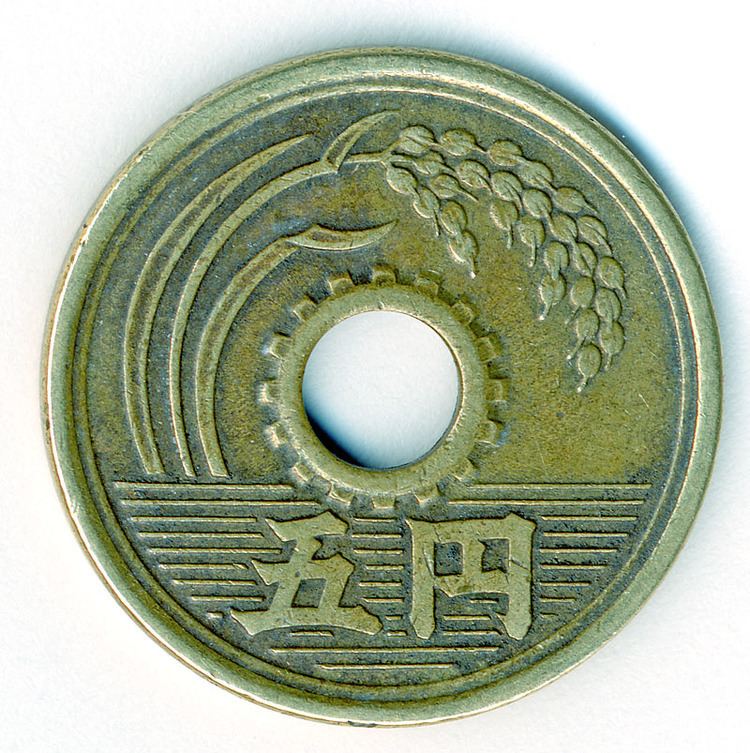Diameter 22 mm Center hole diameter 5 mm | Mass 3.75 g Thickness 1.5 mm Composition c. 65% Cuc. 35% Zn | |
 | ||
The 5 yen coin (五円硬貨, Go-en kōka) is one denomination of Japanese yen. The current design was first minted in 1959 using Japanese characters known as the "new script", and were also minted from 1948-1958 using "old-script" Japanese characters. Five-yen coins date to 1870 (when, due to the much higher value of the yen, they were minted in gold). The modern-day coin was first produced in 1948 with a different styled inscription. This was changed in 1959 and the design has remained unchanged since.
Contents
The front of the coin depicts a rice plant growing out of the water, with "five yen" written in kanji; the back is stamped with "Japan" and the year of issue, also in kanji, separated by sprouts of a tree. The three graphic elements of the coin represent agriculture and fisheries, the key elements of the Japanese first-sector economy. Around a hole, there is a gear that represents industry. It is the only Japanese coin in circulation to lack Arabic numerals on either face.
Cultural significance
The Japanese for "five yen," go en (五円) is a homophone with go-en (御縁), "en" being a word for causal connection or relationship, and "go" being a respectful prefix. As a result, five-yen coins are commonly given as donations at Shinto shrines with the intention of establishing a good connection with the deity of the shrine, and is widely believed it is best to insert a single five-yen coin into a new wallet before inserting any other money.
Use in nuclear accident investigation
Following the nuclear accident at Tokai, Ibaraki in 1999, physicists Masuchika Kohno and Yoshinobu Koizumi showed how this coin could be used to estimate neutron dosage to the surrounding population, by measuring its zinc isotope ratios. They write:
The Japanese 5-yen coin is about 22 millimeters in diameter and 1.5 mm thick, weighs 3.75 grams and has a central hole 5 mm wide. We chose this coin for monitoring neutron exposure because it is widely circulated, the zinc content is precisely controlled, and theThey concluded that the coin could offer information about the total neutron effect during the accident, and about shielding by modern Japanese houses, given that the coins were recovered from indoors.
Showa
The following are circulation dates which cover Emperor Hirohito's reign. The dates below correspond with the 23rd to the 64th year (last) of his reign. All five yen coins that were made before 1959 use Shinjitai, or old script Japanese. In 1949 only, two different styles of writing were used before a more modern one was established in 1950. This second style of writing was used until 1958 when the current script of Japanese took its place in the following year. Coins for this period will all begin with the Japanese symbol 昭和 (Showa).
* = First style
** = Second style
^ = Third style
Heisei
The following are circulation dates in the reign of the current Emperor. Akihito was crowned in 1989, which is marked with a 元 symbol on the coin as a one year type. Coins for this period all begin with the Japanese symbol 平成 (Heisei).
